(This is the third post in a series on our Electric Vehicle. Read Part 1 here and Part 2 here.)
Whoever coined the term Range Anxiety, got it right. The angst we anticipate is a cartoonist’s dream, made of EV driver nightmares. Along with the sticker price it’s the main challenge on the sales floor. In a former post I pictured our first all-electric “car.” It was the 3-wheeled around-towner called GIZMO. I drove it 36,000 all-electric miles during our 16 years in Eugene. It topped out at 45 mph, but it was quick. I could take anyone off the line at a red light…you know, till we got through the intersection! People in other vehicles would often roll down their windows in traffic and thank me for shrinking the carbon footprint they were creating! They were serious. It was pretty fun. But there were always those others…looking down at me and laughing. Guys in jacked-up Dodge Rams were the worst. Always felt like it was some kind of macho thing…even when women were behind the wheel. Almost got run over one time. It went right along with the decals on the truck window depicting all the members of one family in a row with one of the little boys pee-ing on the cat.

I will always remember one of my first trips in the GIZ. I could get 35-40 miles on a charge, not a bad range for working around town, but one day I wasn’t paying attention and I hit the end of the cord. I pulled off and saw I was a mere half block from a Union 76 gas station. Silly me: I was sure they’d love to let me plug in for a few minutes. So I asked, in my most humble-yet-cheery voice if they’d allow me. I don’t remember if he said it or if I just saw it written all over his face: “Why the hell would I support you to put me out of business.” He was more than grumpy…and my offering to pay him for the power made him more so. But he showed me to a plug. It took me 15 minutes to charge enough to get me home. Then I fled the scene fast as my little limp batteries would carry me. There’s a rudeness in my visceral memory from that encounter. It still gives me the runs when I think about it. Range angst is the real deal.
But that was 18 years ago and it took some courage to go electric back then. It is such a different time now with the advent of the affordable 250+ mile range cars hitting the marketplace. And it’s a no-brainer if you own multiple cars. If you care about the world, one of your vehicles must be electric. But I’m also not gonna try to make anyone think it’s better than it is. That’s why we’re talking about it.
Taking a trip in the EV, especially one that’s going to require more than one charge, takes a plan. As I said at the end of the last blog, we must always ask the BIG THREE QUESTIONS OF EV TRAVEL when mapping out our trip:
- Where are the charging stations located?
- Are the stations Level 1, 2, or 3 (how long to add how much range)?
- Can our car actually use the chargers we locate!?!
Answering the first question is fairly easy. To identify potential charging stations along our preferred route, we go to the App on Debbie’s phone. The most helpful we’ve found so far is called “NEXTCHARGE.” You can see we also have CarStations and ChargePoint. When we had the Volt we used PlugShare.
So you go to NEXT CHARGE and pull up a map of wherever you’re going and it will show you the charging stations along your route. The first map below shows all the charging stations in easy reach of our house in McMinnville, Oregon. The other shows stations in the larger western corridor from N. California up into British Columbia. Pretty amazing huh? The network of chargers has really developed over the past 5 years. We have found that traveling north and south in the West is fairly anxiety free.
But knowing where the stations are located doesn’t give us enough information. We have to answer that second question: Are these chargers Level 1, 2 or 3? If all the symbols on each of the maps was a level 2 or 3 and our plugs would work on each of the chargers, we’d be in pretty good shape depending on how fast we needed to travel. But look at the NEXTCHARGE map showing the chargers on Interstate 84 starting at The Dalles on the Columbia River. We had masses of chargers depicted between Portland and Seattle, but head west toward The Dalles and, as you can see, they quickly thin out. So we tap on each of those symbols and get more information. For instance, look at the information that comes up when we tap on the charging station located up the river at Maryhill State Park. See the picture of the actual plug. Oh no! It’s a NEMA 5-15 and you can tell by the picture you’d be plugging into a 110v plug just like plugging into the wall at home. We might be able to make it that far, like to spend the night, but at 4 miles of range per hour of charging it’s gonna take 48 hours to get a full charge from empty. The note above the picture says “slow.” Slow it is. Not gonna lie. It’s a Level 1!
We must know into what we’re plugging ourselves. The next App map shows a charging station up the river at Boardman, Oregon. Oh no! It’s a Tesla charger and we can’t use it at all! Good to know that ahead of time. Knowing how trip planning can stress the best of relationships, this APP could likely be called “Marriage Saver!” BUT…the surprise of surprises in our pre-trip research was the charging station in the small grain-elevator town of Arlington, Oregon.
Pretty incredible there was a charging station there at all. Then we pulled up the pictures of the plugs in Arlington and we could hardly believe it. There was a Level 3 Rapid Charger AND it had a plug that fit our plug!!! Ta duh! We were set to go.
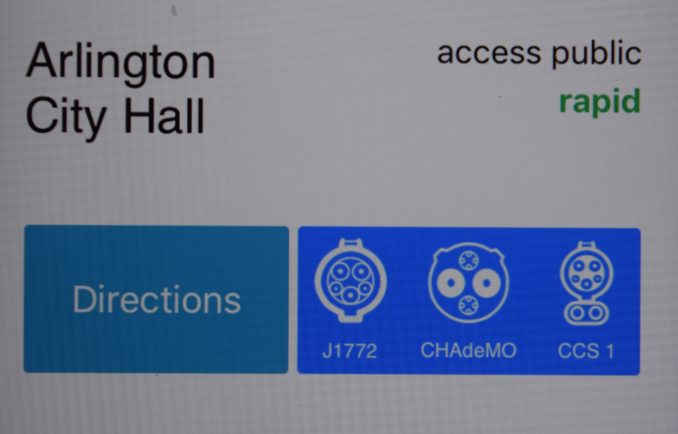
What a relief. Before this discovery, we weren’t sure we could make this trip fast enough to fit our time frame. We’d have hadto stay 36-48 hours in a couple of places. To be clear, from our research we knew there wasn’t a reliable Level 2 charging station in the 180 mile stretch between The Dalles and LaGrande, Oregon. Debbie made phone calls to be sure: the App showed a charger at a Motel near Pendleton, but she phoned them to find it was no longer in service. The App even listed a Level 2 charger in some guy’s garage in Pendleton. He was glad to have us use it but it was going to take a few days for him to re-arrange the crap in his garage to make it accessible. Not gonna go there! We could charge to full in The Dalles, to our full 240 range and probably make it 180 miles to LaGrande. But here’s the thing: between Pendleton and LaGrande are the foothills of the Alps of Oregon (Blue Mountains) and we were really afraid of hitting the end of the cord at 4,200 feet. Climbing takes more power. So when we saw the picture of the Arlington plugs on the App, we did our happy dance!
It is certainly in the realm of the absurd, to discover all charger plugs won’t fit all EV’s. Seriously? But then consider Apple and PC, Democrat and Republican, standard screwdrivers and phillips. We don’t like to standardize things in our brand of Capitalism. Below I show a picture of what the receptacle on our car looks like and the charging plug in our garage that fits it. That’s all there is. Now look at the drawings of the 3 plugs available in Arlington. From left to right:
J1772—-The Level 2 plug that fits our plug—-you can see from the pics, right?
CHAdeMO—-a Level 3—-means “CHArge de MOVE.” It doesn’t fit our plug!
CCS 1—-Level 3—-means “Combined Charging System—-it does fit our plug!
So I hope you get the idea. We can’t charge with all the plugs. The West Coast Electric Highway charging stations are another case in point. These have two plugs: the J1779 and the CHAdeMO, so, at those stations we can use the Level 2, but not the Level 3. CHAdeMO’s are made for Nissan Leafs and their relatives. So there you have it. Once we discovered the CCS 1 combo plug in Arlington, we could do our trip and we finished our planning.

We would take along all the equipment we have, just in case. Pictured above is the unit that comes with the Bolt. It allows us to plug into any 110v outlet anywhere if that’s all we can find. And we would take the plug-in aerovironment charger in case all we could find was a laundromat (hee hee)!




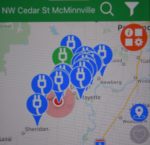


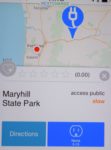

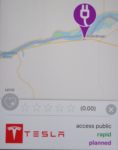



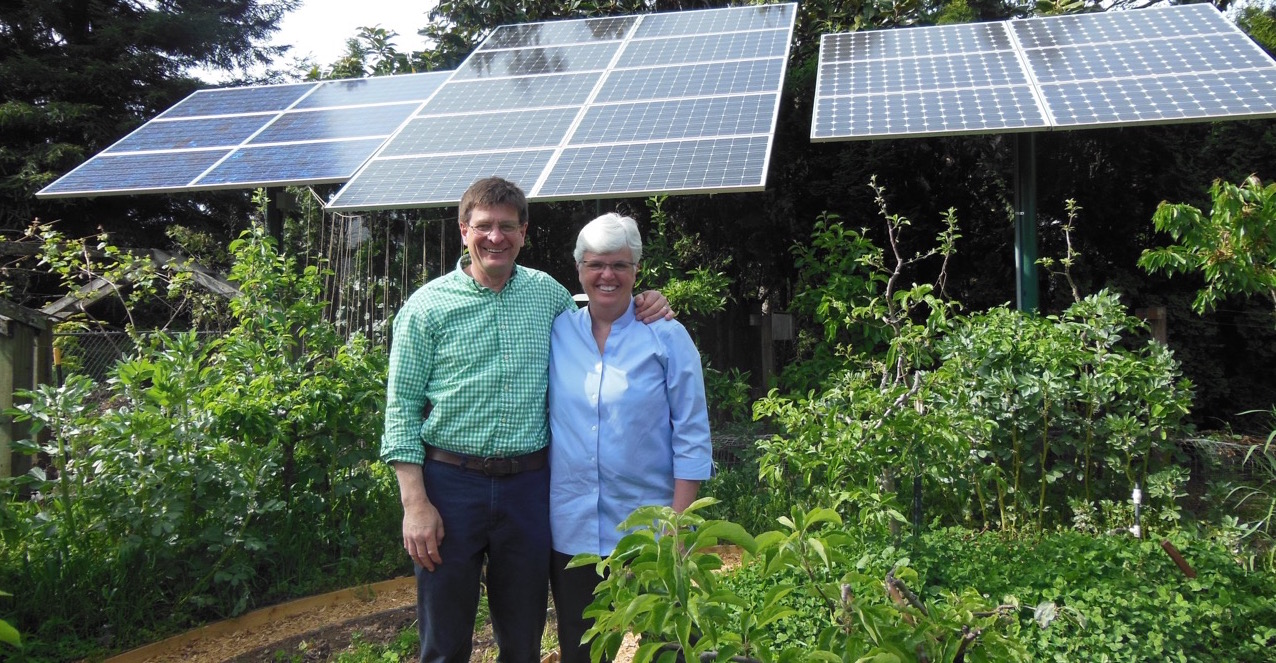






Recent Comments